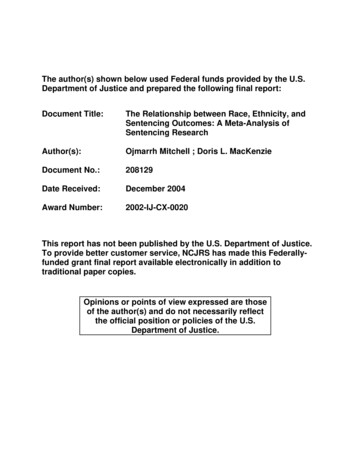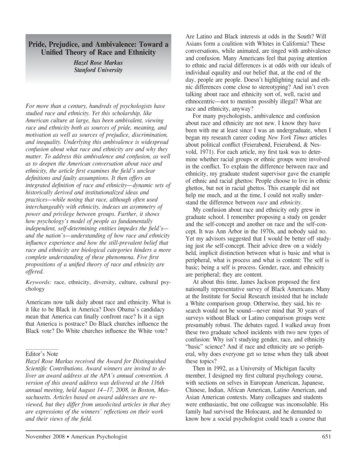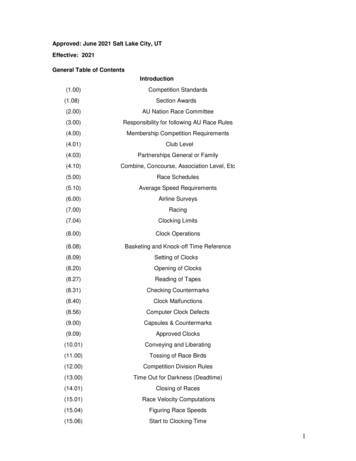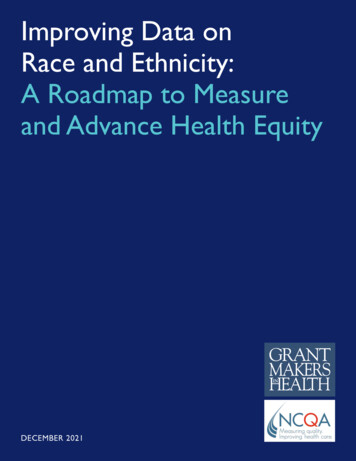
Transcription
The author(s) shown below used Federal funds provided by the U.S.Department of Justice and prepared the following final report:Document Title:The Relationship between Race, Ethnicity, andSentencing Outcomes: A Meta-Analysis ofSentencing ResearchAuthor(s):Ojmarrh Mitchell ; Doris L. MacKenzieDocument No.:208129Date Received:December 2004Award Number:2002-IJ-CX-0020This report has not been published by the U.S. Department of Justice.To provide better customer service, NCJRS has made this Federallyfunded grant final report available electronically in addition totraditional paper copies.Opinions or points of view expressed are thoseof the author(s) and do not necessarily reflectthe official position or policies of the U.S.Department of Justice.
This document is a research report submitted to the U.S. Department of Justice. This report has notbeen published by the Department. Opinions or points of view expressed are those of the author(s)and do not necessarily reflect the official position or policies of the U.S. Department of Justice.The Relationship between Race, Ethnicity, and Sentencing Outcomes:A Meta-Analysis of Sentencing ResearchABSTRACTStatement of Purpose: A tremendous body of research has accumulated on the topic ofracial and ethnic discrimination in sentencing. These studies have produced seeminglydivergent findings. The purpose of this research is to conduct an objective,comprehensive, and systematic review of the literature regarding the relationship betweenrace/ethnicity and sentencing outcomes using quantitative methods (i.e., meta-analysis),which remedy many of the shortcomings inherent in the extant qualitative (narrative)reviews. Further, this research goes beyond simply addressing the question of whetherthere is unwarranted racial/ethnic sentencing disparity, but also addresses the question ofwhy this body of research produces such inconsistent findings.Methods: This research employed meta-analysis to summarize and analyze thevariability in research findings. This meta-analysis established explicit, pre-set eligibilitycriteria that governed inclusion decisions in this review. Hundreds of studies areretrieved; each was closely scrutinized to determine eligibility status. From each study,observed differences in sentencing outcomes by race/ethnicity, independent ofdefendant’s criminal history and seriousness of the current offense, were transformed intoeffect sizes. We also coded features of each study’s sample, methodology, type ofsentencing outcome, and sentencing context.
This document is a research report submitted to the U.S. Department of Justice. This report has notbeen published by the Department. Opinions or points of view expressed are those of the author(s)and do not necessarily reflect the official position or policies of the U.S. Department of Justice.Data Analysis: The data set was analyzed using meta-analytic analogues to traditionalanalysis of variance, and multiple-regression.Results: Eighty-five studies meeting our stated eligibility criteria were located. Analysisof these data reveal that, after taking into account defendant criminal history and currentoffense seriousness, African-Americans and Latinos were generally sentenced moreharshly than whites. Differences in sentencing outcomes between these groups generallywere statistically significant but statistically small (although not necessarily substantivelysmall). Further, analyses indicate that larger estimates of unwarranted sentencingdisparity were found in studies that examined drug offenses, imprisonment ordiscretionary sentencing decisions, and in recent analyses of Federal court data. Smallerestimates of unwarranted sentencing disparity were found in analyses that employedmore control variables (especially those that controlled for defendant SES), utilizedprecise measures of key variables, or examined sentencing outcomes relating to length ofincarcerative sentence. Additionally, there was some evidence to suggest that structuredsentencing mechanisms, such as sentencing guidelines, were associated with smallerunwarranted sentencing disparities. The limited available research contrasting sentencingpatterns of whites to those of Asians or Native Americans does not generally revealsignificant differences between these groups.Conclusions: Overall, these findings call into question the so-called “no discriminationthesis.” These findings suggest that policy-makers need to re-evaluate sentencingpractices, especially in regards to drug offenses and the decision to incarcerate.
This document is a research report submitted to the U.S. Department of Justice. This report has notbeen published by the Department. Opinions or points of view expressed are those of the author(s)and do not necessarily reflect the official position or policies of the U.S. Department of Justice.The Relationship between Race, Ethnicity, and Sentencing Outcomes:A Meta-Analysis of Sentencing ResearchRESEARCH SUMMARYFINAL REPORTSubmitted to the National Institute of JusticeOjmarrh Mitchell, Ph.D.Department of Criminal JusticeUniversity of Nevada, Las VegasDoris L. MacKenzie, Ph.D.Department of Criminology and Criminal JusticeUniversity of MarylandThis project was supported by Grant No.: 2002-IJ-CX-0020 awarded by the NationalInstitute of Justice, Office of Justice Programs, U.S. Department of Justice. Points ofview in this document are those of the author and do not necessarily represent the officialposition or policies of the U.S. Department of Justice
This document is a research report submitted to the U.S. Department of Justice. This report has notbeen published by the Department. Opinions or points of view expressed are those of the author(s)and do not necessarily reflect the official position or policies of the U.S. Department of Justice.The Relationship between Race, Ethnicity, and Sentencing Outcomes:A Meta-Analysis of Sentencing ResearchRESEARCH SUMMARYThe issue of racial and ethnic disparity in criminal sentencing has been one of thelongest standing research topics in all of criminology. At least 70 years of empiricalresearch has focused on this issue without a clear consensus emerging. Over that period,a tremendous body of research has accumulated on this topic. Some studies have foundthat racial/ethnic minorities are sentenced more harshly than whites even after legallyrelevant factors, such as offense seriousness and prior criminal history, are taken intoconsideration. Conversely, a few studies have reached the opposite conclusion–racialminorities are treated more leniently than whites, while still other research has found nodifferences in sentencing outcomes by race/ethnicity of the defendant.The current research reports the results from a quantitative (i.e., meta-analytic)synthesis of empirical research assessing the influence of race/ethnicity on non-capitalsentencing decisions in U.S. criminal courts. Eighty-five studies meeting our eligibilitycriteria were located. From each of these studies, the magnitude and direction ofobserved racial/ethnic disparities were calculated (via effect sizes). That is, from eachstudy we measured the actual size and direction (i.e., which racial/ethnic group wasdisadvantaged) of any observed differences in sentencing outcomes by race/ethnicity.Analyses of these data not only determine whether there is racial/ethnic disparitydisadvantaging minorities, but also estimate the magnitude of such disparity. Perhapsmost importantly, the results of these analyses go beyond addressing the simple question1
This document is a research report submitted to the U.S. Department of Justice. This report has notbeen published by the Department. Opinions or points of view expressed are those of the author(s)and do not necessarily reflect the official position or policies of the U.S. Department of Justice.of whether unwarranted racial disparity exists and attempts to address the question of whystudies of racial disparity in sentences often produce inconsistent findings. We believethat the inconsistent findings exhibited in this body of research can be explained bytaking into account the varying features of each study and characteristics of thesentencing jurisdiction. Specifically, we believe that variations in methodology, sample,and context are systematically related to the results produced by the empirical research.Several authors have attempted to review this voluminous and diverse body ofresearch using traditional qualitative narrative literature review techniques. In manyregards, these reviews are insightful and invaluable; however, it is our contention thatthese reviews are of limited utility because of the qualitative, narrative methodologyemployed in each. Perhaps the most important weakness typically exhibited by thesenarrative reviews is that they overemphasize statistical significance of individualfindings. Existing narrative reviews most often use a “vote-counting” methodology thatsimply determines the proportion of studies finding a statistically significant effect,regardless of the magnitude of this effect. As a result, narrative reviews provide answersto conceptually flawed questions, such as: What proportion of studies show a statisticallysignificant effect of race/ethnicity on sentencing outcomes? This is a flawed question, asin the extreme, this question is nothing more than asking: How many studies used largesamples?The existing narrative reviews are also plagued by a number of othershortcomings. For instance, traditional narrative reviews of the literature most often arenot comprehensive. Most of the existing reviews of the race and sentencing literatureexamined only published studies. This is a significant shortcoming because previous2
This document is a research report submitted to the U.S. Department of Justice. This report has notbeen published by the Department. Opinions or points of view expressed are those of the author(s)and do not necessarily reflect the official position or policies of the U.S. Department of Justice.research in other areas of study have consistently demonstrated that studies reportingstatistically significant results are more likely to be published. This leads to what isoften referred to as “publication bias.” Traditional narrative reviews also, at leastimplicitly, give equal weight to studies of varying methodological rigor. Even the mostcasual perusal of sentencing research reveals that there is a significant amount ofvariation in the methodological rigor of this body of research. Shouldn’t studies withgreater levels of methodologically rigor and/or larger samples be more heavily reliedupon in drawing conclusions? Moreover, the existing reviews of sentencing researchoften include studies based on the same data or very similar data. This practice leads todouble or triple counting what, in essence, is the same study.Most narrative reviews tend to gloss over these issues; however, theseshortcomings can lead to the conclusions of narrative reviews being inconsistent with thedata. An article in Science (Mann 1994) provides a powerful illustration of thispossibility. Mann compared the conclusions of meta-analytic reviews to those ofnarrative reviews in five areas of research and found that narrative reviewsunderestimated the presence and the strength of effects in each of the five research areas.Given the shortcomings of existing narrative reviews of the race/ethnicityliterature, we assert that these narrative syntheses have not utilized the informationcontained in the empirical research in a manner that maximizes knowledge regarding therelationship between race/ethnicity and sentencing decisions. What’s needed is a methodthat objectively, systematically, and comprehensively reviews the literature regarding therelationship between race and sentencing outcomes and that can provide answers to the3
This document is a research report submitted to the U.S. Department of Justice. This report has notbeen published by the Department. Opinions or points of view expressed are those of the author(s)and do not necessarily reflect the official position or policies of the U.S. Department of Justice.substantive issues at hand, instead of focusing on statistical significance of individualfindings.In recent years, the method of “meta-analysis” has become increasingly popular invarious fields including medicine, psychology, and crime prevention research. Metaanalysis has become the preferred method for synthesizing quantitative research becauseit solves many of the problems of narrative literature reviews. Instead of focusing onstatistical significance, meta-analysis focuses on both the observed direction andmagnitude of a relationship by using numerical effect size estimates. Meta-analysis givesmore weight to larger studies, and provides a means of controlling for the methodologicalrigor of studies. In short, standard meta-analysis procedures yield focused,comprehensive, and systematic reviews of a body of research.This study departs from earlier narrative reviews of the race and sentencingliterature in several important ways. First, this research utilizes meta-analytic techniquesthat systematically and comprehensively review all available research (published andunpublished) pertaining to the influence of race and ethnicity on sentencing outcomes,meeting specific eligibility criteria. Second, this study reviews research on both race andethnicity. Prior reviews of the literature tend to focus on contrasting sentencing outcomesbetween African-Americans and whites; whereas, the current study also contrastssentencing outcomes between whites and Latinos, Asians, and Native Americans.Moreover, the meta-analytic procedure utilized in the current research enables us toaddress the question of why studies of racial disparity in sentences often produceinconsistent findings.4
This document is a research report submitted to the U.S. Department of Justice. This report has notbeen published by the Department. Opinions or points of view expressed are those of the author(s)and do not necessarily reflect the official position or policies of the U.S. Department of Justice.The specific aim of this study is to conduct a systematic and comprehensive metaanalysis that examines: 1) whether race and ethnicity are related to sentencing outcomes,independent of offense seriousness and defendant criminal history; 2) in which contextsare racial/ethnic bias most likely to occur (e.g., Southern jurisdictions, jurisdictionswithout structured sentencing); and, 3) whether study findings are systematically relatedto variations in research methodology, sample, and context.The present meta-analytic review conducted a search for published andunpublished studies that assessed the influence of race or ethnicity on sentencingoutcomes. Bibliographic databases (i.e., PsychLit, MedLine, NCJRS, Criminal JusticeAbstracts, Sociological Abstracts, Social Science Citation Index, SocioFile, ConferencePapers Index, and UnCover), reference lists from literature reviews, conferenceproceedings, hand searches of select relevant journals, and dissertations via DissertationAbstracts were searched for potentially eligible evaluations. Potentially eligibleevaluations were retrieved and closely scrutinized to determine eligibility for this review.Additionally, we contacted each state’s sentencing body to determine whether theseorganizations have internally evaluated their jurisdiction’s sentencing practices in regardsto unwarranted racial/ethnic sentencing disparity.The eligibility criteria for inclusion in the present research were that each studyhad to: 1) be conducted using cases sentenced in the United States; 2) examine sentencingoutcomes in criminal courts (i.e., juvenile court adjudication/sentencing outcomes areexcluded); 3) incorporate simultaneous controls for both offense seriousness and criminalhistory; 4) measure the direct influence of race/ethnicity on sentencing outcomes; 5)5
This document is a research report submitted to the U.S. Department of Justice. This report has notbeen published by the Department. Opinions or points of view expressed are those of the author(s)and do not necessarily reflect the official position or policies of the U.S. Department of Justice.examine sentencing outcomes unrelated to death penalty decisions; and, 6) all researchmust be made available through yearend 2002.This meta-analysis focuses on five types of sentencing outcomes: 1)imprisonment decisions, 2) length of incarcerative sentence, 3) simultaneousexaminations of imprisonment and sentence length decisions, 4) discretionary lenience,and 5) discretionary punitiveness. Imprisonment and length of incarcerative sentencedecisions are self-explanatory. The third type of sentencing outcome, what we refer to assimultaneous examinations of imprisonment and sentence decisions, typically analyzesentencing decisions using ordinal scales of measure with non-incarcerative sentences(i.e., probation) being the least severe sentence, short-term incarcerative sentences beingthe next level of severity, and longer-term incarcerative sentences being progressivelymore severe on the ordinal scale. Discretionary lenience refers to sentencing outcomeswhere judges sanction defendants in some manner more lenient than ordinary (e.g.,downward departures from guidelines, stays of sentence). Conversely, discretionarypunitiveness refers to sentencing outcomes where judges sanction defendants moreharshly than ordinary (e.g., upward departures, enhanced sentencing provisions foreligible repeat offenders).From each independent sentencing context, an odds-ratio effect size wascalculated for each minority-white comparison of sentencing outcomes. We chose theodds-ratio effect size because the majority of the minority-white comparisons wereconducted with dichotomous measures of sentencing outcomes (e.g., imprisonment vs.probation). Effect sizes were coded in manner such that larger effect sizes indicateminorities were punished more harshly than whites. Specifically, odds-ratios greater than6
This document is a research report submitted to the U.S. Department of Justice. This report has notbeen published by the Department. Opinions or points of view expressed are those of the author(s)and do not necessarily reflect the official position or policies of the U.S. Department of Justice.1 indicated that the minority group of interest were sentenced more harshly than whites,independent of defendant criminal history and current offense seriousness, with largerodds ratios denoting larger minority-white sentencing disparities; whereas odds-ratiosless than 1 indicated that whites were sentenced more harshly than minorities.Key features of each study’s methodology (e.g., number and nature of controlvariables, how offense seriousness and criminal history were measured), sample (type ofoffenses analyzed, age of sample, gender distribution of sample), type of sentencingoutcome, publication status (published vs. unpublished), and sentencing context (e.g.,region, use of guidelines, time period of data) were coded. These coded variables areused as independent variables to predict variation in the magnitude of observedsentencing disparities between races/ethnicities.A total of 184 studies meeting the stated eligibility criteria were located. Eightyof these studies were excluded from the analyses because they were determined to bestatistically dependent (i.e., analyzed the same data set as another study included in thissynthesis) and 19 studies were excluded because they were uncodeable (usually becausesome vital piece of statistical information was not reported). Finally, nine studiesanalyzed the same data as another study but analyzed a different outcome, these ninestudies were merged with their corresponding studies–leaving 76 eligible and statisticallyindependent studies (these 76 studies encompass the results of 85 studies).Approximately half of the studies included in this research were published as journalarticles (49%), another 14% of studies were published as books or book chapters, and aconsiderable proportion of studies were unpublished (37%).7
This document is a research report submitted to the U.S. Department of Justice. This report has notbeen published by the Department. Opinions or points of view expressed are those of the author(s)and do not necessarily reflect the official position or policies of the U.S. Department of Justice.The descriptive analysis of the studies included in this meta-analysis revealsseveral important points. First, the current research appears to be the mostcomprehensive review of this research, as this meta-analysis includes the results from 85published and unpublished studies. Further, this meta-analysis also appears to becomprehensive in regards to regional representation, as analyses of unwarranted racialdisparity from 29 states, the Federal courts, and Washington D.C. were included. Mostof the included studies analyzed data from the 1970s or 1980s (76%), whereas 17% ofstudies utilized more recent data.Second, it is evident that the methodological rigor in this body of research hasimproved markedly over the past several decades. Analyses of unwarranted racial/ethnicdisparity have included an increasing number of control variables. Most commonly,these controls measure defendant socioeconomic status (SES), type of defense counsel,and method of case disposition—all of which have been found to be related torace/ethnicity and severity of sentencing outcomes. The precision of measurement ofcontrol variables utilized has also improved; for instance, whereas many of the earlystudies employed crude dichotomous measures of important variables, such as offendercriminal history, considerably fewer recent studies employ variables measured in thismanner.Third, most sentencing research focuses on comparing sentencing outcomes ofAfrican-Americans to whites. In fact, 95% of coded studies included contrasts betweenAfrican-Americans and whites, and 66% of all effect sizes contrasted sentencingoutcomes of African-Americans to those of whites. However, an increasing number ofstudies are including empirical assessments of Latino sentencing outcomes. In all, 25%8
This document is a research report submitted to the U.S. Department of Justice. This report has notbeen published by the Department. Opinions or points of view expressed are those of the author(s)and do not necessarily reflect the official position or policies of the U.S. Department of Justice.of coded contrasts compared sentencing outcomes of Latinos to whites and almost all ofthis research was published since 1980. Little research concerns sentencing practices ofNative Americans or Asians as only 5% and 4% of coded contrasts, respectively,compared sentencing outcomes between these minority groups and whites.The effect size analyses revealed that even after taking into consideration currentoffense seriousness and defendant prior criminal conduct, African-Americans and Latinoswere sentenced more harshly, on average, than whites. In regards to contrasts betweenAfrican-Americans and whites, the magnitude of sentencing disparity was highlyvariable, and varied by type of court (State or Federal) in particular. The mean overallodds-ratio for State sentencing contexts was 1.28, which is statistically significant,whereas the mean overall effect size for Federal sentencing contexts was 1.15. It is veryimportant to note, however, that more recent analyses of Federal data yield considerablygreater indications of unwarranted racial disparity; specifically, in analyses of Federaldata collected since 1980, the mean odds ratio effect size was 1.58 compared to a mean of1.02 for analyses conducted with data before 1980. Translating these mean odds ratios inpercentages, while assuming a 50% rate of punishment for whites, suggests that AfricanAmericans in State courts would be punished at a rate of 56% and African-Americans inFederal courts would be punished at a rate of 53%; restricting attention to only morerecent analyses of Federal data would increase the percentage of African-Americansexpected to be punished to 61%.The present research also found that the magnitude of the unwarranted sentencingdisparity disadvantaging African-Americans varied by several other factors. First,estimates of unwarranted racial disparity varied by type of sentencing outcome.9
This document is a research report submitted to the U.S. Department of Justice. This report has notbeen published by the Department. Opinions or points of view expressed are those of the author(s)and do not necessarily reflect the official position or policies of the U.S. Department of Justice.Unwarranted sentencing disparity disadvantaging African-Americans was largest whenimprisonment and discretionary sentencing decisions were scrutinized and smaller whendecisions pertaining to length of incarcerative sentence were assessed. A secondimportant source of systemic variation was type of offense. Specifically, sentencingdisparity was largest in cases that examined sentences for drug offenses and smallest incases involving property crimes. Third, several methodological features were importantmoderators of effect size. Those studies that utilized only a single dichotomous measureof criminal history generated considerably larger estimates of unwarranted disparity thananalyses using more precise measures of this important variable. Likewise, analysesusing imprecise measures of offense severity also produced larger estimates ofunwarranted racial disparity. Smaller estimates of unwarranted racial disparity insentencing were also found in analyses employing more control variables for factorsknown to be related to both severity of sentence and race, especially SES of defendant.Moreover, unpublished studies were associated with smaller estimates of unwarrantedracial disparity than published studies-suggesting that narrative reviews which focus onpublished research utilized a biased sub-sample of all available research. Anotherinteresting finding is that analyses of highly aggregated data (e.g., analyses of data pooledfrom all jurisdictions within one state) produced systematically smaller estimates ofunwarranted sentencing disparity than analyses conducted at a lower (smaller) levels ofaggregation. This finding strongly suggests that aggregation bias affects estimates ofunwarranted racial/ethnic disparity in analyses using higher levels of aggregation. Yet,even after taking into account these various methodological features, our analysesindicate that unwarranted disparity disadvantaging African-Americans persisted.10
This document is a research report submitted to the U.S. Department of Justice. This report has notbeen published by the Department. Opinions or points of view expressed are those of the author(s)and do not necessarily reflect the official position or policies of the U.S. Department of Justice.It is also important to note which variables failed to exhibit meaningfulassociations with effect size. Perhaps most salient, is the weak negative associationbetween effect size and presence of structure sentencing in analyses of State data. At thebivariate level, jurisdictions employing structured sentencing displayed smaller averagelevels of unwarranted racial disparity than jurisdictions without such mechanisms, andthis association was marginally statistically significant. This difference, however, wasnot statistically significant once other factors were taken into consideration. Subsequentmultivariate analyses found that while the presence of structured sentencing continued tohave a modest negative relationship to effect size, this relationship was not statisticallysignificant. Similarly, at the bivariate level, Southern jurisdictions displayed largerestimates of unwarranted disparity than other regions of the U.S., but this relationshipwas not statistically significant after taking into account methodological differencesbetween studies.While a considerably smaller number of studies analyzed contrasts betweenLatinos and whites, analyses of these contrasts found that Latinos in both State andFederal courts generally were sentenced more harshly than whites. Similar to thefindings of African-American/white contrasts, the influence of ethnicity (i.e., beingLatino in comparison to being white) was highly variable. The mean odds-ratio effectsize in these Latino/white comparisons (1.18) was statistically small but statisticallysignificant. Also similar to the findings of African-American effect sizes, unwarrantedLatino/white sentencing disparity was greatest when imprisonment and discretionarysentencing outcomes were examined and in offenses involving drugs. In contrast to theanalyses of African-American/white contrasts, methodological features of the analyses11
This document is a research report submitted to the U.S. Department of Justice. This report has notbeen published by the Department. Opinions or points of view expressed are those of the author(s)and do not necessarily reflect the official position or policies of the U.S. Department of Justice.were not as strongly related to effect size. In fact only two methodologicalcharacteristics, the use of selection bias corrections and number of variables measuringcriminal history, were statistically related to effect size.In regards to sentencing outcomes of Asians and Native Americans, few contrastswere available. The findings from the few available studies, however, indicate thatsentencing disparity between these racial groups and whites were statistically small. Theaverage difference in sentencing outcomes between Native Americans and whites wasvery small and not statistically significant. The difference between Asians and whiteswas not statistically or substantively significant in State courts; however, the differencebetween these groups was statistically significant but small in analyses of Federal courtd
relationship between race/ethnicity and sentencing decisions. What's needed is a method that objectively, systematically, and comprehensively reviews the literature regarding the relationship between race and sentencing outcomes and that can provide answers to the 3 This document is a research report submitted to the U.S. Department of Justice.










